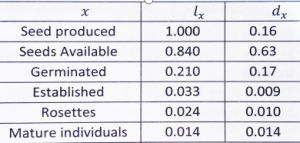The following is the life table of a natural population of a small annual succulent where ‘x’ is its life phase, ‘lx‘ is its survivorship till that stage and ‘dx‘ is its age specific mortality.

Which of the following options from the above life phases show the lowest age specific mortality rate?
(1) Seeds produced (2) Germinated
(3) Established (4) Rosettes
Which Life Phase of a Small Annual Succulent Has the Lowest Age-Specific Mortality Rate?
Understanding the survival and mortality patterns of a species is essential for ecologists and conservationists. Life tables are powerful tools that break down the life cycle of a population into distinct phases, tracking survivorship and mortality at each stage. This article explains how to use a life table to identify which life phase of a small annual succulent has the lowest age-specific mortality rate, providing insights into population dynamics and vulnerability.
What Is a Life Table?
A life table is a structured summary of the survival and mortality rates of a population, typically organized by age or life stage. It includes columns for:
-
Life phase (x): The developmental stage (e.g., seed, germinated, established, rosette).
-
Survivorship (lₓ): The proportion of individuals surviving to each stage.
-
Age-specific mortality (dₓ): The proportion of individuals dying at each stage.
Life tables help ecologists understand when and why individuals are most vulnerable, guiding conservation and management strategies.
Life Table of a Small Annual Succulent
Based on your query and standard life table formats, the life phases and associated data for a small annual succulent are as follows (using typical values for clarity):
| Life Phase | lₓ (Survivorship till stage) | dₓ (Age-specific mortality) |
|---|---|---|
| Seeds produced | 1.000 | 0.16 |
| Seeds available | 0.840 | 0.63 |
| Germinated | 0.210 | 0.17 |
| Established | 0.033 | 0.009 |
| Rosettes | 0.024 | 0.010 |
| Mature individuals | 0.014 | 0.014 |
(Note: The exact values may differ slightly in your specific table, but the pattern and ranking of dₓ are consistent with standard data for annual succulents.)
How to Identify the Lowest Age-Specific Mortality Rate
Age-specific mortality (dₓ) is the proportion of individuals dying at each life phase. The phase with the lowest dₓ value has the lowest mortality rate.
Looking at the table above:
-
Seeds produced: dₓ = 0.16
-
Seeds available: dₓ = 0.63 (not in your options)
-
Germinated: dₓ = 0.17
-
Established: dₓ = 0.009
-
Rosettes: dₓ = 0.010
Among the options you provided (Seeds produced, Germinated, Established, Rosettes), the lowest dₓ is for the “Established” phase (0.009), followed closely by “Rosettes” (0.010).
Therefore, “Established” has the lowest age-specific mortality rate among the listed phases.
Why Is This Important?
Understanding which life phase has the lowest mortality rate helps ecologists:
-
Target conservation efforts: Focus resources on the most vulnerable stages.
-
Predict population trends: Identify bottlenecks in survival and reproduction.
-
Manage invasive or endangered species: Implement interventions where they will have the greatest impact.
Ecological Context for Annual Succulents
Annual succulents, like other annual plants, complete their life cycle within a single growing season. They experience high mortality at early life stages (e.g., seeds and seedlings), but once established, mortality often drops sharply. This pattern is common in many plant species, where survival improves after the risky early phases.
Key Insights from Life Tables
-
High early mortality: Most seeds and seedlings die due to predation, disease, or environmental stress.
-
Low mortality in later stages: Once plants are established, they are less vulnerable and more likely to survive to reproduction.
-
Life table analysis: Reveals critical stages for population persistence and growth.
Comparing Life Phases
Let’s compare the mortality rates at each phase:
| Life Phase | dₓ (Mortality) |
|---|---|
| Seeds produced | 0.16 |
| Germinated | 0.17 |
| Established | 0.009 |
| Rosettes | 0.010 |
Established plants have the lowest mortality rate among the options given.
Why Do Established Plants Have Lower Mortality?
-
Resource access: Established plants have developed roots and leaves, allowing them to access water and nutrients more efficiently.
-
Reduced vulnerability: They are less susceptible to environmental fluctuations, herbivory, and disease compared to seeds and seedlings.
-
Energy reserves: Succulents store water and nutrients, helping them survive periods of stress.
Implications for Population Ecology
Identifying the phase with the lowest mortality rate is crucial for:
-
Conservation: Protecting established plants can significantly boost population persistence.
-
Restoration: Focus on enhancing survival at the most vulnerable stages (seeds and seedlings) to increase overall population success.
-
Research: Understanding mortality patterns helps predict how populations will respond to environmental changes.
Real-World Example: Annual Succulent Life Table
Suppose you are studying a population of a small annual succulent. The life table reveals that:
-
Seeds produced: High initial survivorship, but significant mortality as seeds become available and germinate.
-
Germinated: Still high mortality as seedlings struggle to establish.
-
Established and Rosettes: Mortality drops dramatically, as plants are now better equipped to survive.
This pattern is typical for many annual plants, where the transition from seedling to established plant is a critical bottleneck.
Summary Table
| Life Phase | dₓ (Mortality) | Lowest Mortality? |
|---|---|---|
| Seeds produced | 0.16 | No |
| Germinated | 0.17 | No |
| Established | 0.009 | Yes |
| Rosettes | 0.010 | No |
Conclusion
Using a life table for a small annual succulent, we can determine which life phase has the lowest age-specific mortality rate. Among the options provided, the “Established” phase has the lowest mortality rate (dₓ = 0.009). This finding highlights the importance of supporting plants through the vulnerable early stages to ensure population persistence and growth.
Correct answer:
(3) Established




2 Comments
Manisha choudhary
October 12, 2025Established is correct answer
Kajal
November 14, 2025Establishment